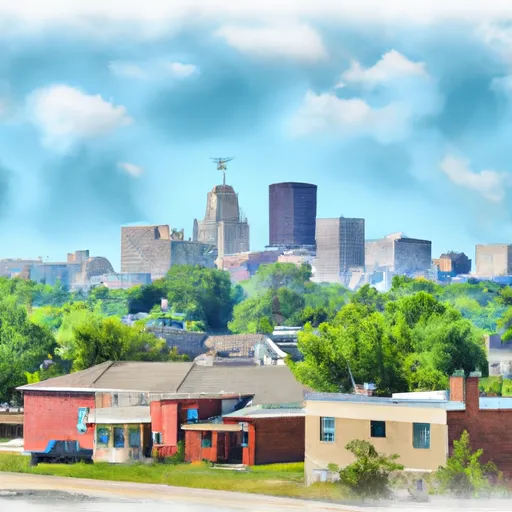-
 Snoflo Premium
Snoflo Premium
Get unlimited access to all our content
With no Ad interruptions! - Start Your Free Trial Login with existing account
Richmond-Heights
Eden Index
Climate
8.3
•
Recreation
4.6
•
Community
5.0
•
Safeguard
6.2/10

Richmond Heights is a charming suburb located in St. Louis County, Missouri. It experiences a humid subtropical climate with four distinct seasons. Summers are hot and humid, with temperatures averaging around 90°F (32°C). Winters are generally mild, with temperatures ranging from 20°F (-7°C) to 40°F (4°C). Spring and fall offer pleasant temperatures, making them ideal for outdoor activities.
The hydrology constituents in Richmond Heights are primarily influenced by the nearby Missouri River. The city does not have any major bodies of water, but it is part of the Meramec River watershed, which contributes to its hydrological system. The area also includes several small creeks and streams.
Richmond Heights boasts numerous outdoor recreation opportunities. It has several beautifully maintained parks, such as Richmond Heights Memorial Park and Hanley Park, offering spaces for picnicking, walking, and playing sports. The nearby Shaw Nature Reserve provides a stunning natural setting for hiking, birdwatching, and exploring diverse ecosystems. Additionally, the city is conveniently located near several golf courses, including The Highlands Golf and Tennis Center and Ruth Park Golf Course, catering to golf enthusiasts. With its pleasant climate and various outdoor amenities, Richmond Heights offers residents and visitors ample opportunities to enjoy nature and engage in recreational activities.
What is the Eden Index?
The Snoflo Eden Index serves as a comprehensive rating system for regions, evaluating their desirability through a holistic assessment of climate health, outdoor recreation opportunities, and natural disaster risk, acknowledging the profound impact of these factors on livability and well-being.
Climate Health Indicator (CHI): 8.3
Richmond-Heights receives approximately
1037mm of rain per year,
with humidity levels near 84%
and air temperatures averaging around
14°C.
Richmond-Heights has a plant hardyness factor of
6, meaning
plants and agriculture in this region thrive during a short period during spring and early summer. Most
plants will die off during the colder winter months.
By considering the ideal temperature range, reliable water supplies, clean air, and stable seasonal rain or snowpacks, the Climate Health Indicator (CHI) underscores the significance of a healthy climate as the foundation for quality living.
A healthy climate is paramount for ensuring a high quality of life and livability in a region, fostering both physical well-being and environmental harmony. This can be characterized by ideal temperatures, reliable access to water supplies, clean air, and consistent seasonal rain or snowpacks.
Weather Forecast
Streamflow Conditions
Upper Mississippi-Meramec
Area Rivers
Upper Mississippi-Meramec
Snowpack Depths
Upper Mississippi-Meramec
Reservoir Storage Capacity
Upper Mississippi-Meramec
Groundwater Levels
Recreational Opportunity Index (ROI): 4.6
The Recreational Opportunity Index (ROI) recognizes the value of outdoor recreational options, such as parks, hiking trails, camping sites, and fishing spots, while acknowledging that climate plays a pivotal role in ensuring the comfort and consistency of these experiences.
Access to outdoor recreational opportunities, encompassing activities such as parks, hiking, camping, and fishing, is crucial for overall well-being, and the climate plays a pivotal role in enabling and enhancing these experiences, ensuring that individuals can engage in nature-based activities comfortably and consistently.
Camping Areas
| Campground | Campsites | Reservations | Toilets | Showers | Elevation |
|---|---|---|---|---|---|
| Lefleurs Bluff State Park | None | 288 ft | |||
| Lake Mary Crawford | 20 | 293 ft | |||
| Greenville - Lake Wappapello | None | 382 ft | |||
| Mississippi Petrified Forest | 15 | 294 ft | |||
| Percy Quin State Park | None | 416 ft | |||
| Bogue Chitto Water Park | None | 276 ft | |||
| Fairview Riverside State Park | None | 4 ft | |||
| Lake Lincoln State Park | None | 426 ft | |||
| Bayou Segnette State Park | None | 0 ft | |||
| Pere Marquette State Park | 80 | 644 ft |
Nearby Fishing
Nearby Ski Areas
Catastrophe Safeguard Index (CSI):
The Catastrophe Safeguard Index (CSI) recognizes that natural disaster risk, encompassing floods, fires, hurricanes, and tornadoes, can drastically affect safety and the overall appeal of an area.
The level of natural disaster risk in a region significantly affects safety and the overall livability, with climate change amplifying these risks by potentially increasing the frequency and intensity of events like floods, fires, hurricanes, and tornadoes, thereby posing substantial challenges to community resilience and well-being.
Community Resilience Indicator (CRI): 5.0
The Community Resilience Indicator (CRI) recognizes that education, healthcare, and socioeconomics are crucial to the well-being of a region. The CRI acknowledges the profound impact of these elements on residents' overall quality of life. By evaluating educational resources, healthcare accessibility, and economic inclusivity, the index captures the essential aspects that contribute to a thriving community, fostering resident satisfaction, equity, and social cohesion.

